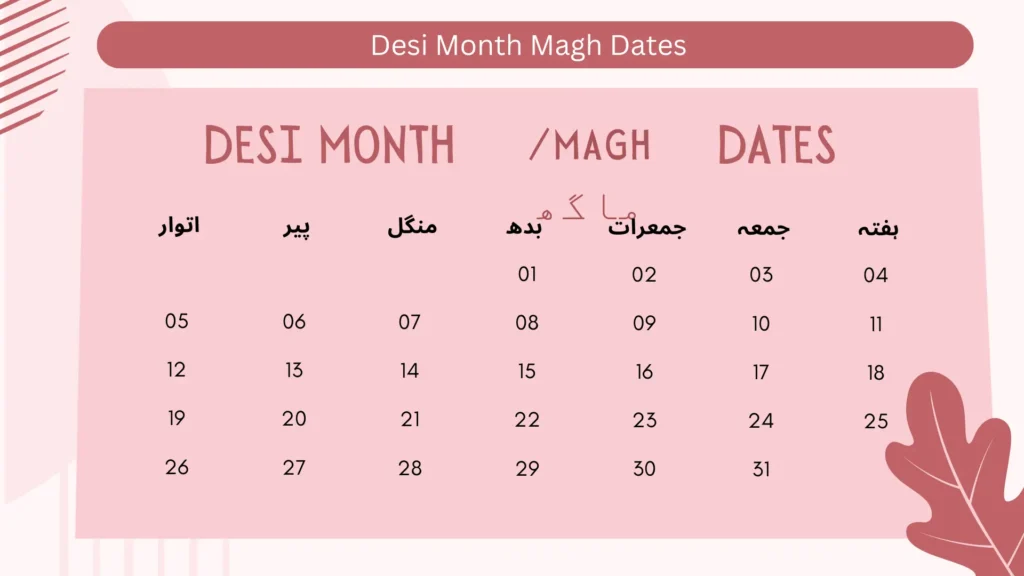Desi Month Magh Dates 2024 Aligned with English (Gregorian) Dates
You can easily find the dates for the Desi month Magh in 2024, matched with the English calendar. This helps you keep track of important dates for cultural, religious, or personal reasons. The Magh dates are shown in both Desi and English formats, and you can even check today’s Desi month date, Sangrand, and Gurpurabs. Additionally, discover other Desi month dates for 2024: Chet, Vaisakhi, Jeth, Harh, Sawan, Badhon, Assu, Katak, Maghar, Poh, and Phagun.
The Desi calendar often called the Punjabi calendar, is deeply ingrained in the cultural and agricultural life of the Indian subcontinent. Desi month Magh, also known as Magha, is the eleventh month of this calendar and corresponds to 13 January to 11 February in the Gregorian calendar. This month is marked by the continuation of winter, important agricultural activities, and various festivals celebrated by Muslims, Sikhs, and Hindus. This blog provides a detailed overview of the month of Magh, its relevance in different calendars, weather patterns, agricultural significance, and cultural festivities.
Introduction to Desi Month Magh in Various Calendars

- Desi Calendar (Punjabi Calendar): Magh represents the middle of winter and is critical for the Rabi cropping season. This month is a period of intense agricultural activity and preparation for the harvest.
- Nanakshahi Calendar: The Nanakshahi calendar, adopted by the Sikh community, modernizes the ancient Bikrami calendar. Magh in the Nanakshahi calendar aligns with 13 January to 11 February in the Gregorian calendar, encompassing important Sikh observances and celebrations.
- Bikrami Calendar: The Bikrami or Vikram Samvat calendar, an ancient lunar-solar calendar used in India and Nepal, includes Magh as a significant month. This period is celebrated with traditional Hindu festivals and rituals, reflecting the region’s cultural richness.
Weather During Desi Month Magh
Desi month Magh is characterized by the peak of winter, bringing significant changes in weather patterns:
- Temperature: The temperatures during Magh range from 5°C (41°F) to 15°C (59°F). The days are typically cold, and the nights can be very chilly, often dipping below freezing in some regions.
- Rainfall: Magh generally experiences minimal rain, which leads to dry conditions. Any precipitation that does occur is usually light and sporadic, sometimes in the form of winter showers or dew.
- Humidity: Humidity levels are lower than in other months, resulting in dry and crisp weather typical of winter.
- Agricultural Activities: This month is vital for the growth of Rabi crops. The cold, dry weather is ideal for wheat, barley, mustard, and other winter crops to thrive.
Festivals and Cultural Significance During Desi Month Magh
Desi month Magh is a culturally rich month with numerous festivals celebrated by Muslims, Sikhs, and Hindus. These festivals are deeply embedded in religious traditions and seasonal cycles.
- Muslim Festivals:
- According to the lunar Islamic calendar, no significant Muslim festivals typically occur in the month of Magh, but local practices and observances may vary.
- Sikh Festivals:
- Maghi: This festival commemorates the martyrdom of the forty Sikhs who fought for Guru Gobind Singh Ji. It is observed with religious gatherings, prayers, kirtans (devotional songs), and community meals (langars).
- Birth of Guru Har Rai Ji: The birth anniversary of the seventh Sikh Guru, Guru Har Rai Ji, is celebrated with prayers, kirtans, and special services in Gurdwaras.
- Hindu Festivals:
- Makar Sankranti: Falling in mid-January, Makar Sankranti marks the sun’s transition into the zodiac sign of Capricorn. It is celebrated with kite flying, bonfires, and feasting.
- Basant Panchami: This festival, also known as Vasant Panchami, celebrates the arrival of spring and is dedicated to Saraswati, the goddess of wisdom and arts. It involves wearing yellow clothes, offering prayers, and flying kites.
Agricultural Importance of Desi Month Magh
The month of Magh is significant for agriculture in the Indian subcontinent. Here are some critical aspects of its agricultural importance:
- Rabi Crop Growth: Magh is crucial for the growth of Rabi crops. Farmers ensure these crops receive adequate water and nutrients during this critical growing phase.
- Soil Preparation and Maintenance: Farmers continue to prepare and maintain the soil for optimal crop growth. This includes weeding, applying fertilizers, and managing irrigation systems to support the healthy development of Rabi crops.
- Water Management: Effective water management practices are essential during Magh to ensure adequate moisture for the crops. This includes the use of irrigation systems and water conservation techniques.
- Pest and Disease Control: During this month, farmers are vigilant about controlling pests and diseases to protect their crops and ensure a healthy harvest.
Traditional Practices and Rituals During Desi Month Magh
Desi month Magh is rich in traditional practices and rituals that reflect the region’s cultural heritage and agricultural cycles. These practices are often intertwined with religious beliefs and seasonal changes:
- Religious Observances: During the various festivals in Magh, special prayers, fasting, and rituals are expected. These practices seek divine blessings for prosperity, health, and good harvests.
- Folk Songs and Dances: Magh’s cultural vibrancy is reflected in folk songs and dances that celebrate the winter season, agricultural activities, and festivals. These performances are an integral part of community gatherings and celebrations.
- Ritual Offerings: Farmers and families make offerings to deities and nature spirits, seeking protection and blessings for their crops and households. These offerings often include grains, fruits, and flowers.
- Community Feasts: Festivals during Magh are often accompanied by communal meals, where families and communities come together to share food and celebrate. These feasts strengthen social bonds and promote a sense of unity.
Conclusion
From 13 January to 11 February, the Desi month of Magh is a period of great cultural, religious, and agricultural significance in the Indian subcontinent. It marks the peak of winter, bringing cooler and drier weather ideal for the growth of Rabi crops and the continuation of various agricultural activities.
Festivals such as Maghi, the Birth of Guru Har Rai Ji, Makar Sankranti, and Basant Panchami bring communities together in celebration, reflecting the region’s rich cultural diversity. Traditional practices and rituals during Magh highlight the deep connection between nature, agriculture, and religion, showcasing the people’s resilience and adaptability.
Understanding the significance of Magh helps us appreciate the intricate relationship between the natural cycles of the earth and the cultural practices of communities. As we delve into the rhythms of this desi month, we gain insights into the vibrant and dynamic traditions that have sustained and enriched the lives of people in the Indian subcontinent for centuries.
